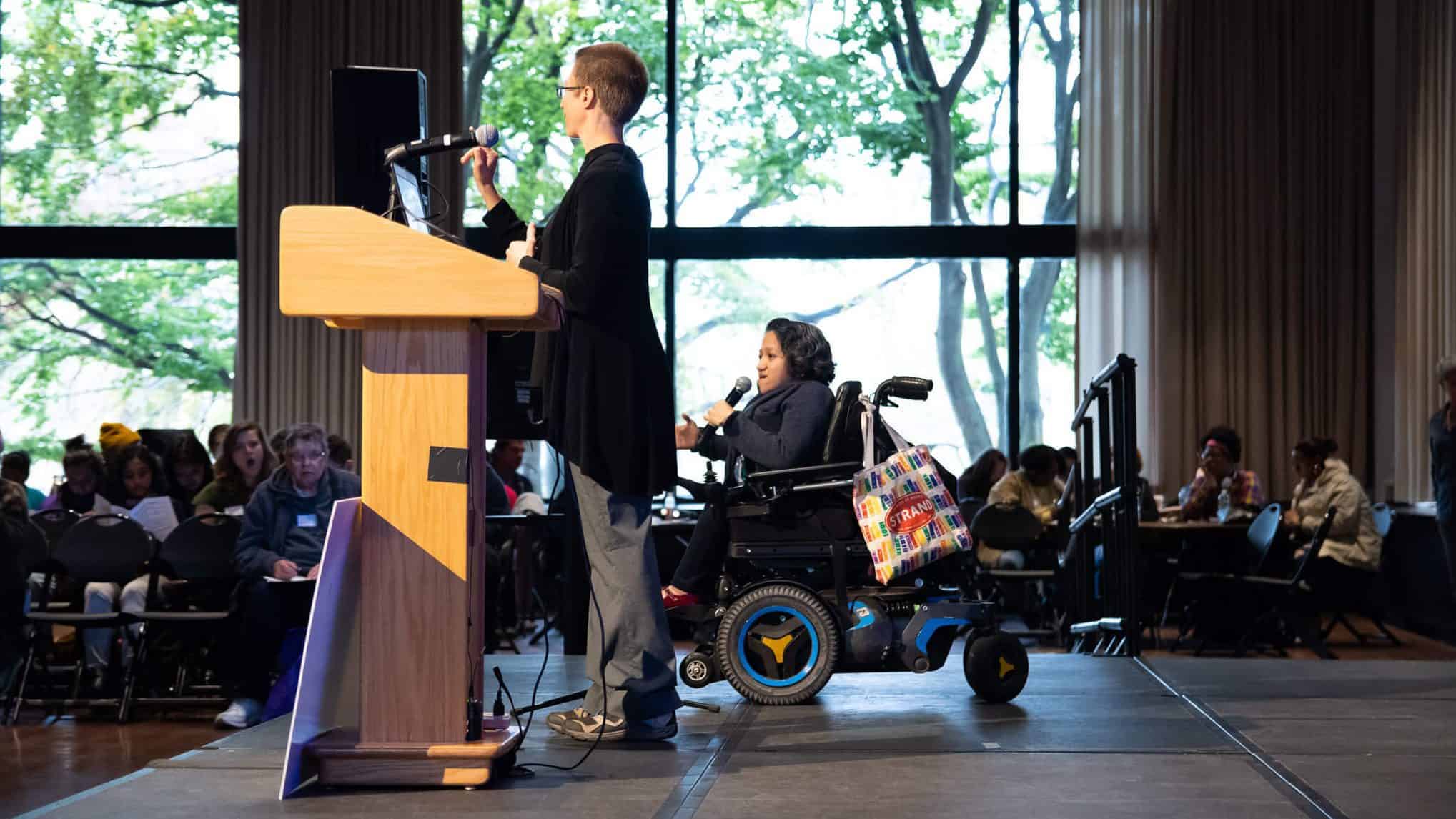The Disability Intersectionality Summit: A Gathering for Justice
On a damp and chilly Saturday in mid-October, I rolled out of bed several hours earlier than I usually would have in order to attend the biannual Disability Intersectionality Summit in nearby Cambridge, Mass on the MIT campus.
Groggy but enthusiastic, I stumbled down the stairs of my affordable housing complex and eagerly awaited The Ride–a discounted taxi service for disabled folks in the Boston metro area. After the pickup time came and went (as well as many minutes more), I called the dispatcher to check in. They could not locate the taxi. I waited another twenty minutes in the downpour and called again. They were condescending to me, conveying that this was just how it was, not caring that I was on assignment and they were jeopardizing my ability to do my job. The taxi finally showed up forty minutes after the proposed pick up time, and the driver shrugged his shoulders when I mentioned his lateness. I tried to impress upon The Ride the irony of a taxi service for disabled folks being forty minutes late to bring me to a conference on disability justice that I was covering for a media site focused on disability rights, but it was lost on them. However, to me it made the mission of the conference I was about to attend all the more clear and crucial.
While I missed the opening plenary and the first breakout session, I was at least early enough to attend all the subsequent ones. As inherent in the title of the summit, its theme was how other marginalizations often intersect with disability–whether that be sex, class, sexual orientation, gender identity, immigrant status, and race. As such, the first session I attended was concentrated on how immigration is in fact a disability rights issue, with the main focal point being the current administration’s recent “zero tolerance” immigration policies at the border that separate children from their parents or guardians, confining those children while detaining or deporting the adults.
In particular, the presenter talked about a new proposal to the “public charge” provision as related to the Immigration Act of 1882. According to the provision, someone who is a public charge is “primarily dependent” on government assistance for more than half their income. However, under the Trump administration this rule would be expanded to also encompass other means-tested government benefits in addition to cash welfare and Social Security Income such as Medicaid, food stamps (SNAP), and housing assistance. Also, it would lower the income percentage threshold to include anyone who accepts these benefits if they equate to financial assistance that meets or exceeds even 15% of federal poverty guidelines (which is tantamount to only $1,800 a year, or $150 per month). Since disabled folks are more likely to use such federal assistance programs than the general population, these proposed changes would directly discriminate against disabled immigrants. The public comment period on this proposed rule change is now open and closes on December 10th. The presenter also mentioned how the immigrant children currently being held in confinement will inevitably experience significant trauma, which experts have noted is directly linked to the development of both psychological disorders and even physical medical conditions. This means our country’s leadership is proactively creating a disabled population it also intends not to service (or at least service well).
After lunch, I then attended the book reading for Leah Lakshmi Piepzna-Samarasinha’s Care Work: Dreaming Disability Justice. Piepzna-Samarasinha offered a rousing reading and speech, drawing from explicit excerpts of her book that offered a radical vision for reform in our society that would fully recognize and include disabled individuals of all backgrounds and identities. Specifically, the book espouses a path that especially lifts up queer disabled folks of color. Part of the reading relayed that this could be achieved only when our society is finally ready to fully accommodate people in the disability community–without all the rigid rules and expectations that by default are exclusionary to all who are not straight, cis, white, and able-bodied.
Shortly after the reading ended, representatives of the anti-incarceration group Black and Pink took the stage to strongly declare that there can be no disability justice behind bars. As someone who is the child and niece of individuals who spent much of their adult lives incarcerated, I had a vested interest in attending this specific session. Douglas Rogers, a former inmate with the Massachusetts Department of Corrections, was first to speak. He relayed his own experiences on the inside of the prison system, referencing the sexual and physical abuse he suffered by prison guards where he was being held. He also described the lack of accommodations and limited care for disabled inmates, including those with mobility restrictions who often did not have access to wheelchairs. Incarceration disproportionately impacts low income folks and people of color, even as these demographics also tend to have chronic health conditions at higher rates than average. Douglass and co-presenter Shaya French noted that our criminal justice system in the United States is excessively punitive, with only 5 percent of all cases even making it to a jury trial and many serving sentences for non-violent drug-related offenses.
Similar to the issue of detaining immigrant children, conditions in our prison can contribute to severe trauma, effectively creating or exacerbating illnesses that can be debilitating–as can be the abuse suffered by inmates at the hands of those guarding them. As with the situation along the border, inmates are not receiving adequate healthcare services and resources while in their confinement.
While I was interested in and intrigued by all of the sessions I attended, it was these three that struck a particularly strong chord in me and underscored the need for comprehending but fully integrating intersectionality when it comes to disability rights. As noted by the DIS founder and ADAPT member Anita Cameron during the closing keynote, the issue of disability rights has historically been whitewashed and tends to overlook those of other marginalized identities. It’s time to bring everyone into its folds. The conversations sparked at this summit were an impressive initiator of this effort that will hopefully culminate in more progressive and inclusive approaches to disability justice.
About Rooted In Rights
Rooted in Rights exists to amplify the perspectives of the disability community. Blog posts and storyteller videos that we publish and content we re-share on social media do not necessarily reflect the opinions or values of Rooted in Rights nor indicate an endorsement of a program or service by Rooted in Rights. We respect and aim to reflect the diversity of opinions and experiences of the disability community. Rooted in Rights seeks to highlight discussions, not direct them. Learn more about Rooted In Rights



